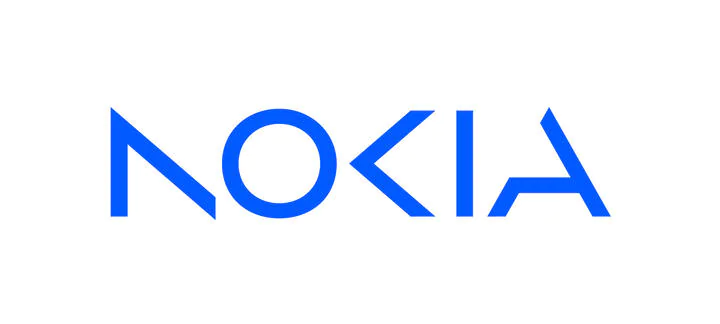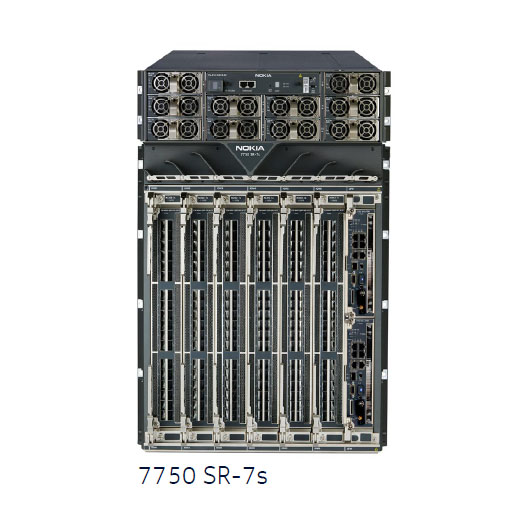Nokia 7750 SR-7s
Service Router
The Nokia 7750 SR-s series of IP routers takes edge and core routing to new heights. It delivers the speed, capacity, power efficiency, flexible capability, network security and automation tools essential for IP networking in the 5G and cloud era. With continuous design innovation and proven investment protection, the 7750 SR-7s helps build a sustainable IP network that can evolve with changing needs for years to come.
Nokia 7750 SR Series Product Family
As networks experience unprecedented traffic growth and unpredictable demands, operators are challenged to increase network capacity efficiently and meet ever-increasing performance requirements while rolling out new services. Leveraging Nokia 6.0 Tb/s FP5 and 3.0 Tb/s FP4 silicon, the 7750 SR-s addresses today’s network imperatives, enabling operators to build a scalable, secure, automated and efficient network.
With platforms scaling from 1.6 Tb/s full duplex (FD) to 216 Tb/s FD, the 7750 SR-s delivers powerefficient performance certainty for demanding network roles. The 7750 SR-s supports a mix of port speeds and optic types: 800G QSFP-DD, 400G QSFP-DD, 400G QSFP112, 100G SFP-DD, 100G QSFP, 400G QSFP, 100G QSFP28 and CFP2-DCO. This variety enables high-density 800GE, 400GE, 200GE, 100GE, 50GE, 25GE and 10GE interfaces as well as hardware support for 1.6 Tb/s flows.
At the heart of the 7750 SR-s is Nokia FP silicon — an essential element for high-performance routing. Leveraging a fully programmable network processor (NP) architecture, the systems are designed to be deterministic, enabling diverse deployment needs for demanding IP edge, core and smart aggregation applications under all network operating conditions.
Running the Nokia Service Routing Operating System (SR OS), the 7750 SR-s delivers deployment versatility and consistency. It provides a common platform to optimize IP edge and core functions and services without performance compromises. Extensible hardware and SR OS feature licensing allows each system to be tailored to meet exact networking requirements in the most economical way. These industry-leading capabilities enable network designs without trade-offs among performance, capacity, scalability and power consumption. To protect against increasing security threats, the 7750 SR-s embeds security across all aspects of the data path without impacting router performance.
Features & Benefits
- There are six system variants in the 7750 SR-s product family: the FP4-enabled Nokia 7750 SR-1s and Nokia 7750 SR-2s; the FP5-enabled Nokia 7750 SR-1se and Nokia 7750 SR-2se; and the Nokia 7750 SR-7s and Nokia 7750 SR-14s, which support a full concurrent mix of FP4 and FP5 silicon. All platforms support universal line cards, with support for any speed on any service on any port, ranging from 10GE to 800GE, with full breakout options on all ports. Please refer to the 7750 SR-s XMA2-s, 7750 SR-s XMA-s and 7750 SR IOM-s data sheets for more details on line card variants. Optical breakout options include 4 x 10G, 10 x 10G, 4 x 25G, 2 x 100G, 4 x 100G, 2 x 400G and 8 x 100G. This is all provided within the same product family, in platforms ranging from 1.6 Tb/s FD to 216 Tb/s FD.
-
Sustainability
The power-efficient design of the 7750 SR-s makes IP networks more sustainable through reduced emissions. With power density optimization, a best-in-class mechanical design for optimal cooling, 112G SERDES, integrated memories and smaller silicon geometries, an FP5-based system deliversm typical power consumption in the order of 0.1W/Gig in chassis-based systems1. Even more, with FP silicon, performance is always deterministic.
This power consumption is realized with full features enabled while concurrently being fully buffered on both ingress and egress, with line rate memories on buffers and tables. With FP5 silicon, there is no compromising router performance or minimizing features to achieve this level of power efficiency.
The line card design of the 7750 SR-s dynamically scales power consumption based on licensing levels and connectors in use. This significantly reduces consumption when only a fraction of a line card is in use. With multiple license configurations and line card/system options, operators have flexibility to design network locations with the right power consumption, performance, capacity and scalability to achieve sustainability goals.
System efficiency
The mechanical and thermal design of the 7750 SR-s is focused on enabling operators to maximize the density and usability of coherent 1 FP5-based 7750 SR-s typical power consumption is expected to be below this figure. Power measurements are pending. 2 Enabled via software in a future release. optics. Today’s coherent optics, such as 400G ZR/ZR+, can consume power above 20W and are a challenge to cool in data center-focused router designs. The design of the 7750 SR-s line cards and systems allows for a full set of coherent 400G ZR/ZR+ optics in all cages without restrictions or fan algorithm changes. In addition, cards and systems are equally ready to support 800G coherent optics without density trade-off. The intent of coherent optics is to leverage full router density without losing ports and without sacrifice, and that is exactly what the 7750 SR-s design delivers. Leveraging 112G SERDES technology, the 7750 SR-s unlocks the power efficiency advantages of nextgeneration optics. 800G QSFP-DD optics save in the order of 25 to 43 percent of the optical power budget compared to using two 400G QSFP-DD optics. It is hardware-ready to support power-efficient 100G/200G SFP112 and 400G QSFP optics. As systems densify, optics become a larger part of overall system power consumption, and the power savings behind next-generation optics quickly becomes compelling.
FlexE 2.02 is supported across all of channelization, sub-rating and bonding. Bonding support enables 1.6 Tb/s clear-channel flows in advance of 1.6 Tb/s optics availability and can increase link level efficiencies by mitigating the inefficiencies associated with link aggregation group (LAG) hashing. In combination, these capabilities provide a futureready set of functions to deliver investment protection over the long term. -
Network processor-based architecture
Every generation of Nokia FP silicon has been based on an NP design. A Nokia NP offers the highest degree of flexibility and programmability in the industry. With a fully programmable data path and zero hard-coded logic, FP silicon is fully upgradable to new hardware-based performance standards with a simple software update. The value of a fully upgradable data path has been shown over several generations of FP deployments, where segment routing (SR), Ethernet virtual private network (EVPN) and IEEE 1588 Precision Time Protocol (PTP) edge timestamping have been activated in hardware without the need for hardware swaps on silicon delivered before these standards were conceived. With uncertainty around future evolving network standards, an NP-based architecture delivers the lowest TCO compared to any other chipset architecture on the market.
Deterministic performance: Tables, buffers and QoS
The NP architecture of FP silicon has been designed to be fully deterministic across tables and buffering under all network loading conditions. Nokia-designed smart memories for tables and line rate buffer memories make this design possible, allowing high-scale routing with full access control lists (ACLs) and services with no performance trade-off. This enables certainty at full scale and under realworld network conditions from Day 1 through Year 10 and beyond. A line rate memory system will always outperform a non-line rate memory system under all network loading conditions without exception.
Full buffering for ingress as well as egress data combined with packet pre-classification and pre-buffering ensures superior performance for all critical flows. This guarantees the traffic that matters most regardless of port configuration, microbursting or network congestion. Our FP NPs support all necessary QoS features, from basic to advanced, in a highly granular way. They support a full set of QoS with up to 16 queues per service, five-layer hierarchical QoS (H-QoS), and an industryleading total number of queues and policers. QoS capabilities provide tremendous capability for broadband network gateway (BNG) and quadplay services but can equally be scaled to deliver optimized, lean performance.
Intelligent aggregation
Intelligent aggregation allows the 7750 SR-s to cost-effectively aggregate port capacity beyond the forwarding capacity of a line card in a deterministic way while guaranteeing QoS and packet priority. The 7750 SR-s supports up to 19.2 Tb/s (FD) per slot of intelligent aggregation, enabling it to collapse the pre-aggregation layer or expand port availability without adding line cards. This capability significantly reduces the number of network elements for power savings and can deliver savings in the order of onethird the cost of a traditional leaf/spine topology, resulting in significantly lower TCO from both CAPEX and OPEX savings. This is all possible without increased power or feature trade-offs.
Pay-as-you-grow licensing
The flexible pay-as-you-grow licensing model for hardware capacity and functions provides a choice of entry points for immediate requirements and the ability to scale in-place for evolving needs without hardware changes. Throughput rates are also available where capacity can be scaled down, lowering power consumption proportionally, and to provide the right power, performance and port mix in the most economical way. In-service SR OS right to use (RTU) licenses can be activated with many pay-as-you grow license options, ensuring that performance and port capacity are not constrained by maintenance windows.
Service richness
Nokia’s feature-rich, 64-bit SR OS addresses the full spectrum of IP routing requirements. With comprehensive QoS, IP/MPLS, SR and model-driven management features, the 7750 SR-s has the service capabilities and tools to meet the most stringent SLAs and deliver the highest end-user quality of experience (QoE). The 7750 SR-s supports hundreds of thousands of IP flows and access control lists (ACLs) with high performance at scale, even when multiple processing-intensive features are enabled concurrently. It supports advanced push-based telemetry models to stream flowlevel data and insights in near-real time for network assurance and DDoS security. The 7750 SR-s supports multi-dimensional table scaling where IP, MPLS, ACL and MAC addresses can all scale concurrently. Tables can all grow simultaneously and concurrently, allowing the true potential of network designs to be unleashed without constraint. Trading off scale in one dimension for another is a recipe for compromise and will constrain network growth over the long term
Speed and capacity
Power
Flexible capability







